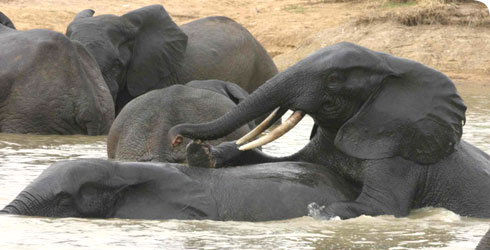Biology
Reproduction
Elephant reproduction is slow; a female gives birth only every four or five years:
- Usually to one calf at a time
- Twinning occurs in roughly one in 100 births
- Birth weight is around 120kg
Growth to adulthood is also a long process. In consequence, a tremendous amount of time and energy is expended in the rearing of the young, a task that falls entirely to the females.
Elephant cows become sexually mature at the age of 12-14, and begin to reproduce soon after that date. Bulls start producing sperm around the same time, but in practice rarely father any calves until they are approaching 30.
Female elephants come into oestrus about every 16 weeks and are sexually receptive for only a day or so during this period, so male and female behaviour must be tightly attuned. A male, especially when in musth, will visit female groups, searching for oestrus females by touching their vulvas with the tip of his trunk. He then touches his trunk tip on a specialised taste gland, the Jacobson’s organ, on the roof of his mouth. It has recently been discovered that the females’ urine contains a pheromone indicating that she is in oestrus. She will also signal her readiness by behavioural cues. Copulation begins as the male reaches over the female’s shoulder with his trunk from behind. The female exerts some choice in the matter and may run off even at this stage. Otherwise, the bull mounts her, placing most of his weight on his back legs. The penis is S-shaped, up to 1 m long, and highly muscular, finding and entering the vulva without pelvic movement. The testes are internal (unusual in mammals) and situated near the kidneys; up to a litre of ejaculate is produced. The bull may remain with the female for anything from a few hours to a few days, mating with her occasionally and guarding her from the advances of rival males.
Pregnacy
Pregnancy lasts about 22 months, and birth, accomplished with the mother squatting or lying, is assisted by other females of the group. The two mammary glands are situated between the front legs (unusual for quadrupedal mammals). Calves suckle until the second or third year or even longer, depending on when the next calf is born. Male calves suckle more frequently than females and, after the first few years, the difference in size between them becomes apparent. Female calves will remain in their family unit for life, eventually taking over its leadership, while males leave at sexual maturity, often aided by increasing impatience of the mother.
In drought years, cows are unlikely to come into oestrus, naturally regulating their reproduction. Otherwise, they can conceive at any time of year, but in seasonal environments, a definite peak has been observed some weeks after the onset of the rains. With a 22-month gestation, this ensures that the calf will be born when rainy-season greening has begun two years later, providing the mother with a rich food supply for lactation.
